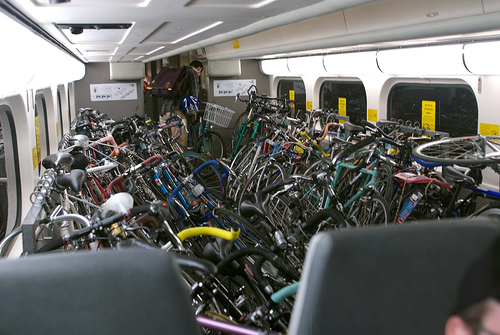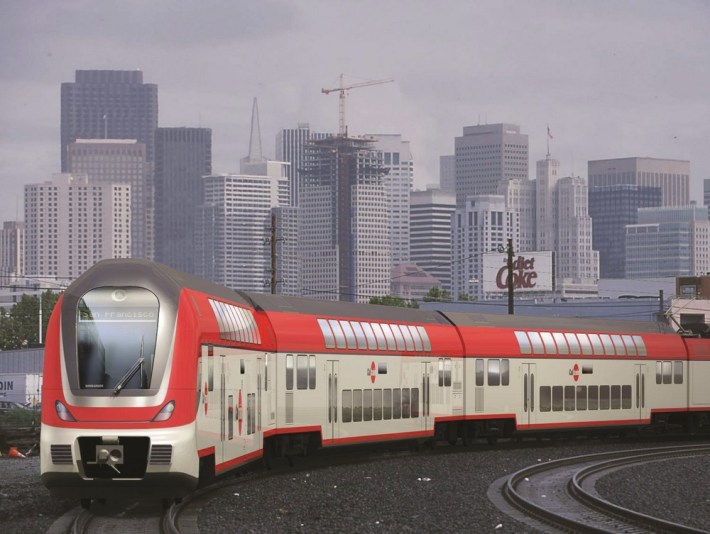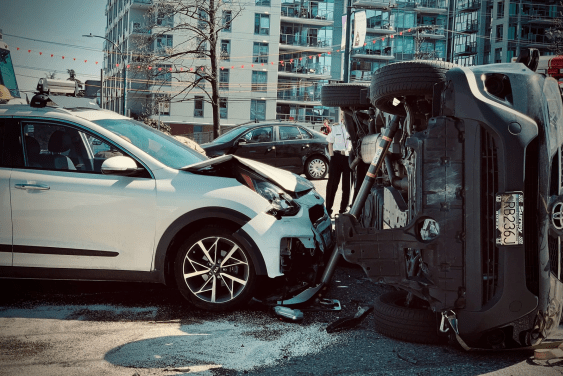Note: An earlier version of this article's headline indicated that the increase in bike capacity came at the expense of bathrooms. The two were features were essentially unrelated.
The Caltrain Board of Directors voted today to increase the share of space on its future electric trains devoted to bike capacity, though the trains may lack bathrooms.

The Caltrain board rejected a proposal from its staff to include one bathroom on every six-car train while maintaining the same seat-to-bike ratio that exists today of ten-to-one. After a push from board member Tom Nolan, who is also the chair of the SFMTA Board, that ratio was increased to eight-to-one in the request for proposals from train manufacturers
The board also requested a report on the costs of adding more bathrooms and bike parking at stations.
"The board’s refusal to go along with the status quo" for on-board bike capacity "is a real victory for improving regional transit," said SF Bicycle Coalition Executive Director Noah Budnick in a statement.
"We hear from folks all the time about how Caltrain’s current car design causes people to be late for work or to pick up their kids because there isn’t enough space for them on the train they needed to catch,” he said. "When transit options don’t meet the needs of a community, you see more people turn to private autos for their commutes."
The SFBC and the Silicon Valley Bicycle Coalition had pushed for a six-to-one bike capacity ratio, as well as funding to build more secure and convenient bike parking at stations to reduce the need for bikes on-board. The Caltrain board approved $3 million for station bike parking.
SVBC Executive Director Shiloh Ballard said in a statement that the organization "is excited with this initial investment in bike parking for Caltrain stations that emphasizes the importance of bike access."
According to Adina Levin of Friends of Caltrain, however, an estimated $9 million would be needed to provide enough bike parking for 20 percent of Caltrain riders to bike, if trains have an on-board bike capacity ratio of nine-to-one. With the eight-to-one ratio in the RFP, the necessary investment to accommodate 20 percent of passengers won't be quite so large, but $3 million will certainly fall far short.
While some trains could still include a bathroom, it's not mandated. Levin and other Caltrain riders were not pleased about the vote against on-board bathrooms:
@Caltrain_News if caltrain is going to remove bathrooms, they also need to not have significant service delays every other day.
— Melissa Redmond (@ReallyMelissaR) July 2, 2015
Levin wondered if the board is "really serious about bathrooms at the stations given the struggles of BART to open and clean bathrooms" which have been closed since 9/11.
According to a tweet from Levin, Caltrain board member Ash Kalra, of San Jose, pushed to eliminate the on-board bathroom mandate "because [electric] trains will be faster (but not that much faster)." When electric Caltrain service starts in 2019, the trip from SJ to SF is expected to be about 45 minutes, roughly 10 minutes shorter than today.






